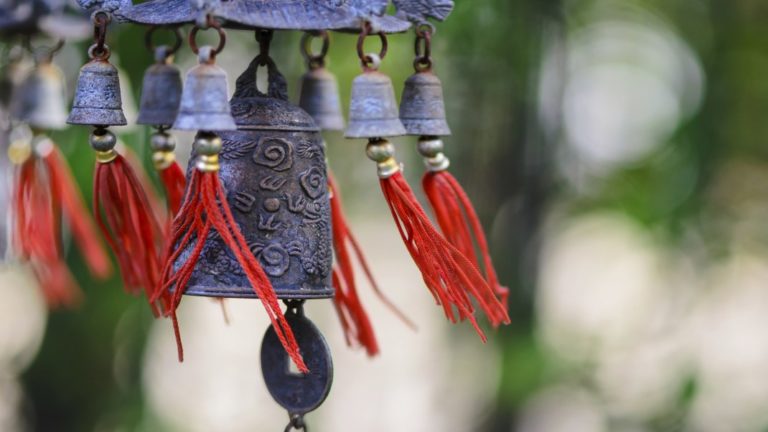Aleister Crowley’s Thoth Tarot: An Esoteric Primer

There may be more divination card decks on the market than kombucha flavors, and they just keep coming — animal, mineral, and vegetable (really) themes with everything in between — angels, a Spanish “Días de las Muertes” (Day of the Dead) deck, and a “Crystal Unicorn” tarot. There’s even a “Mystical Manga” deck. But all were preceded by 20th century occultist Aleister Crowley’s Thoth tarot, the product of 500 years of tarot history and Crowley’s vision.
Tarot History
The 14th century Italian aristocracy played a card game, “tarocchi,” using the oldest known cards, the Visconti-Sforza deck. Cards such as the fool, death, the sun, and justice, may have been derived from Venetian carnivale characters.
In 1789, a tarocchi-derived fortune-telling deck emerged, with 22 major and 56 minor arcana cards divided into coins, cups, swords, and wands suits representing the four elements — earth, water, fire, and air. Twenty-two trump cards correspond to the 22 paths on the kabbalistic tree of life. The oracle deck was linked to the Egyptian god Thoth, adding to the tarot’s air of mystery. The cards, their suits, and major arcana were also linked to gypsies, a disparaging name for the Romani people, who many believed were from Egypt (since disproven).
The Hermetic Order of the Golden Dawn
A fin de siècle fascination with occult subjects in literature and art grew throughout Europe into the early 20th century. Secret societies orders appeared, including The Hermetic Order of the Golden Dawn, an esoteric occult society. The Golden Dawn emerged in England and spread throughout Europe, with Crowley as a member of the London temple in 1898 — he fell out with the Golden Dawn in 1902, but was inspired to direct an esoteric order of his own.
“Crowley had been interested in Tarot since his involvement with the Hermetic Order of the Golden Dawn; indeed, one of the tasks of Golden Dawn membership was to create one’s own tarot deck based on traditional images and magical, qabalistic, and astrological information,” according to Lon Milo Duquette, author of the definitive Understanding Aleister Crowley’s Thoth Tarot.

The Rider Waite Major Arcana Cards
Interest in the symbols with their layered meanings in the classic tarot was not exclusive to the Golden Dawn — the Waite-Smith deck, created by Golden Dawn member A.E. Waite, and illustrated by Pamela Colman “Pixie” Smith, was designed for commercial distribution.
“Waite and Pixie Smith were both Golden Dawn initiates, but Waite did not ask Smith to represent qabalistic and esoteric symbolism on the cards which were always intended to be marketed to the uninitiated. The images on Waite-Smith court cards and small cards were not qabalistically based at all, but drawn from visions Smith received while listening to readings from the Grail Romances,” said Duquette. The Waite-Smith deck evolved into the Rider Waite deck, now published by U.S. Games Systems. A version of the earlier Visconti-Sforza deck is also available.
Book of the Law and the Ordo Templis Orienti
In 1904, after leaving the Golden Dawn, Crowley travelled to Egypt. He reported that while there, he received a channeled text called “The Book of the Law.” At the heart of this text was the message, “Do what thou wilt shall be the whole of the law; love is the law, love under will.”
More visions came in 1909 during trips to Mexico and the Sahara Desert — Crowley used the experiences as inspiration for a series of initiations, similar to the Golden Dawn, but with an urgency based on Crowley’s belief that humanity was poised on the brink of profound evolutionary change.
In 1910, Crowley joined the Ordo Templi Orientis (OTO). Two years later he was the head of the OTO in Great Britain and Ireland. Eventually, as the “Outer Head of the Order” until his death in 1947, he integrated principles from his Book of the Law into ODO curriculums and raison d’etre.
Crowley’s Thoth Tarot
In roughly 1938, Crowley’s student, Lady Frieda Harris, suggested a re-imagined tarot based on the Book of the Law. She volunteered to produce all the art for the major and minor arcanas, saying she was directed to do so by her holy guardian angel. For the next several years, the two collaborated on the deck with Harris working tirelessly to translate Crowley’s vision to paint and canvas. According to Duquette, she had studied Rudolf Steiner’s concept of projective geometry with two of his students, and expressed those ideas in her compositions.
In his book on the Thoth tarot, Duquette writes, “When we ask what makes the Thoth Tarot unique, the first and most obvious answer is the artwork. However difficult it may be to grasp the mathematical subtleties of projective geometry, we see it thrillingly manifested in Harris’s use of lines, nets, arcs, swirls, twists and angles combined to visually redefine the fabric of space.”
The paintings, laden with symbols and references to kabbalah, astrology, alchemy, numerology, magickal correspondances, and The Book of the Law, were finished in 1943, and used to illustrate the first edition of Crowley’s “The Book of Thoth.” Crowley died in 1947, and Harris in 1952 — neither would see the paintings published as tarot cards. The Thoth Tarot deck would not be commercially published until 1969.
Duquette skillfully explores the similarities and differences between Crowley’s Thoth tarot and Golden Dawn tarot attributes. In his book he has published comparative charts illustrating complex relationships between the two systems, specifically those of the 22 trump cards, or major arcana.
The Fool
The rich symbolism in the Thoth deck, and comparisons of Crowley’s archetypes to their corresponding major arcana cards, has been accomplished in Duquette’s book. That said, a look at the fool card, the alpha and omega of any version of the major arcana, is an example of the contrast of traditional interpretation to Crowley’s vision.
The fool is one of the most complex symbols in Western esoterica, from mythology to standard playing cards, and Crowley held his own views on this symbol.

L. Rider Waite Tarot Fool R. Thoth Tarot Fool
The fool archetype can appear as the madman, the beggar, and the vagabond. He is usually in ragged clothing, often carries a staff, and is also portrayed with the classic jester’s hat with bells. He is first cousin to the archetypal Trickster — in fact, he often fills that role.
One source characterizes the fool as sacred, saying, “Holy fools subvert prevailing orthodoxy to point to the truth which lies beyond immediate conformity.” In other words, the fool points to the emperor’s new clothes as nakedness — he is the guileless child, and innocence is a prime characteristic of our fool. He disrupts anything safe or politically correct, exposing convention as hypocritical and counterfeit.
The fool is the clown and the court jester. In literature he appears as Shakespeare’s Puck in “A Midsummer’s Night Dream,” and in cinema, as Marx brother Harpo Marx, of whom Crowley was aware. Duquette writes, “Harpo was the archetypal fool — the girl-chasing clown who made fools of straightlaced, uptight characters — he did it without saying a word. Harpo was silent like the mythological characters from whom the fool is constructed; Harpocrates, the Greek god of innocence, and Dionysus, silent when asked by king Pentheus, “What is Truth?” Duquette notes finding images of Harpo Marx in Crowley’s own notes.
The Rider Waite fool is gazing into the sky above, about to step off a cliff — a little dog tries to warn him. The tarot fool is traditionally interpreted an indication of new beginnings, spontaneous action, leaps of faith, and innocence or naivete. When the card appears reversed, it indicates bad decisions or choices.
Crowley’s Thoth tarot Fool throws off simplistic meanings, presenting himself as a composite of several powerful symbols. Duquette writes, “He is the pagan Green Man of spring; Parsifal, the pure fool who wins the holy grail; Hoor-Pa-Kraat, the innocent Egyptian lord of silence treading on the back of the crocodile god Selbek, the Devourer.”
Duquette also notes that Harris’s portrayal is a “Cornucopia of sacred images, many of which reveal themselves only after long meditation (and the aid of a magnifying glass).” Harris’s fool is accompanied by a dove of innocence, or as Duquette suggests, the holy spirit. A butterfly references transformation. A vulture, shown in part above the butterfly, represents Maut, the Egyptian vulture goddess. Duquette interprets a winged globe as a symbol of Mercury, and quotes Crowley himself; “The whole picture is a glyph of the creative light.”
Every composition of the Thoth deck is multi-layered with meaning — some clear, others obscure or cryptic, based on Crowley’s interpretations. Every color, line, gesture, and object carries a symbolic message. As dive into Crowley’s Thoth deck is an immersive study of the occult, hermeticism, gematria, the Kabbalah’s tree of life, astrology, mythological gods and goddesses, and ritual magick.
Feng Shui Space Clearing and Salt Water Cure

As an energetically sensitive being, we may find ourselves affected by people, events and even spaces. Though subtle, we can often feel the shifts of energy which can bring us discomfort and unease. Practices clearing these spaces starts in our physical environment. When this physical container is clear, it allows the light of our soul to expand and create greater manifestations from within.
Feng Shui is an ancient practice of maximizing the energetic flow of a physical space. All things have Chi/Qi – a life force energy which is always in motion.
Paying attention to these trusted principles can help us be in more cooperation with the harmony of life around us. When we apply these methods, we may discover ease, joy, abundance and creativity is more easily able to find us.
Stagnation occurs when there is no flow. This stuck energy can feel like something is off, lethargy and simply being uninspired. When this blockage is allowed to fester, arguments, sickness, depression and loss of material wealth may result. The tensions will certainly mount if we do not pay proper attention to how energy is allowed to move around us. Feng shui space clearing is one practice we can engage to ensure the flow remains.
When to Clear Your Space
While routine cleansing should be a normal part of your home care, I like to also clear, charge and bless the home during significant moon phases like the Full and New Moons, during eclipses and at the holy-days. Each will give us a subtle reset which can program the energy of our space to resonate with our own intentions.
When matched with sacred days honored throughout time, we will get an extra boost in the form of blessings from the natural world. If we can match the vibration of clear intent with our personal goals, energies can more clearly manifest for us.
Anytime you feel unsettled in your space, this is a good indicator that feng shui space clearing may help. More obvious reasons could be a fight, a trauma or guests who may not match your frequency, which also offer an ideal time to clear your physical space.
Moving into a new home can be hectic, but merging with your new space so that it may be ready to hold all of you is also a must. Clear out the old tenants and introduce yourself to your home room by room.
And don’t feel like this ritual cleansing only applies to your home! Cars, offices and yards are carriers of energy and may need our attention from time to time.
Works spaces likewise are crucial as we all have tensions that arise at work. A little bit of feng shui clearing will help us be more focused, productive and at ease in this most important aspect of our lives.
Negative Energy
In feng shui, salt can purify “negative” energy bringing the charge back to neutrality. Some people feel the new energy as clear, purified and clean. It can then hold and lift the intentions we set.
Let us acknowledge that just because something feels funky, it doesn’t necessarily equate to evil or “negative.” Rather it is simply a disruption that affects our energy fields.
Like a duck swimming in a dirty pond, the dirty water is not bad, it is just affecting the duck in ways that are not optimum for its well being. Energy is the same, to label it as negative or bad will only program it to be so. Energy is neutral, it’s subtle affect on us is where we can be patiently aware.




































